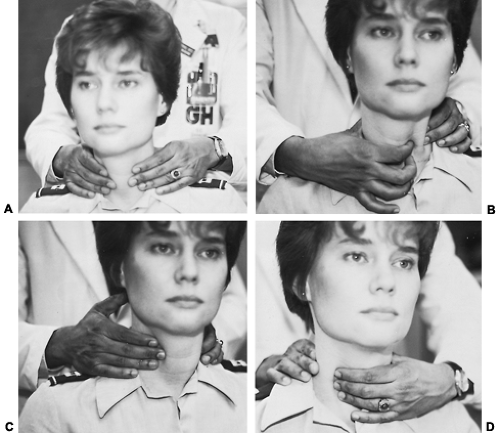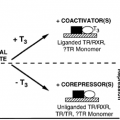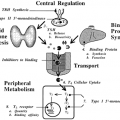EXAMINATION OF THE THYROID GLAND
Some features of the general physical examination are of particular interest in a patient with a suspected thyroid disorder. These include the texture and temperature of the skin, the degree of perspiration, the pulse rate, the deep tendon reflex relaxation time, hoarseness of the voice, facial or periorbital puffiness, ophthalmopathy, edema, apparent weight loss, tremor, and reduced muscle mass or muscle weakness.
Examination of the thyroid is facilitated by the ready availability of water to expedite swallowing. Many patients tend to hyperextend their necks at the beginning of the examination, thinking that this simplifies the palpation when it actually makes it more difficult. The patient’s neck should be flexed only slightly, so as to relax the sternocleidomastoid muscles. The neck is inspected for visible goiter or masses, both at rest and during swallowing. Nonthyroidal masses do not move up and down with swallowing because they do not lie within the fascial sheathing of the trachea. That a midline mass may represent a thyroglossal duct cyst (with embryo-logic derivation from the hypoglossal region) may be inferred from its cephalad excursion on protrusion of the tongue. Plethoric suffusion of the face on raising both arms to the sides of the head (Pemberton sign) suggests a retrosternal goiter brought up into a thoracic inlet narrowed by the goiter and causing obstruction to venous return.
Palpation of the thyroid is performed best from behind, with the patient in a seated position (Fig. 28-2). The author does not concur with earlier dogma that maintained that a palpable thyroid indicated goiter or disease because the normal gland usually could not be palpated; with patience and experience, a normal gland can be palpated. The size of the normal thyroid varies directly with body size. The average thyroid gland weighs 14 to 18 g. Those physicians who estimate the weight of enlarged glands usually do so on the basis of a comparison to the weight of the normal gland. That is, a gland that is thought to be approximately three times larger than normal would be described as weighing 45 to 55 g.
 FIGURE 28-2. Technique for physical examination of the thyroid gland. A, The thyroid is examined from behind, with the patient in a sitting position, avoiding hyperextension of the neck. B, The exploring fingers determine the extent of the gland, after which attention is directed to the size, consistency, and presence of any nodules. C, By using the fingertips alternately to displace the gland to the contralateral side, an appreciation of deeper abnormalities may be gained. This is particularly effective when the sternocleidomastoid muscle is thickened, in which case direct palpation would be difficult. D, Examination for lymphadenopathy is conducted in a routine manner but should be especially thorough in the presence of a thyroid nodule.
Stay updated, free articles. Join our Telegram channel
Full access? Get Clinical Tree
 Get Clinical Tree app for offline access
Get Clinical Tree app for offline access

|



